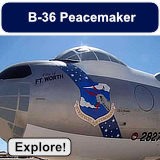
Military Airplane Boneyards and Scrapping Depots After World War II
Military aircraft played a key role in the United States's victory over enemy forces in World War II.
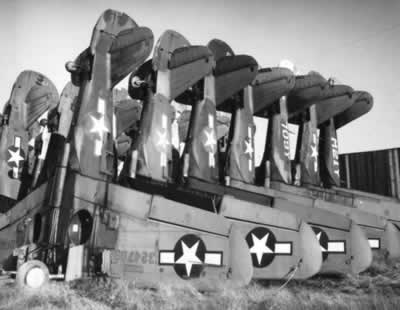 Curtiss P-40 Warhawk fighters stacked vertically at Walnut Ridge, Arkansas after World War II (Photo by the Walnut Ridge Army Flying School Museum) |
However, once peace was assured, the military found itself with a huge surplus of aircraft. The United States had manufactured about 294,000 aircraft for the war effort. Of that number, 21,583 (7.34%) were lost in the United States in test flights, ferrying, training accidents, etc., and 43,581 were lost en route to the war and in overseas operations.
By 1944 the U.S. Foreign Economic Administration began a program to scrap certain obsolete, damaged and surplus military aircraft overseas. Following the war, estimates of the number of excess surplus airplanes ran as high as 150,000. Consideration was given to storing a substantial number of airplanes, but the realization that the expense to store them was too great ... many needed to be sold or scrapped.
Some U.S. military aircraft overseas were not worth the time or money to bring back to the States, and were consequently buried, bulldozed or sunk at sea. Most, however, were returned home for storage, sale or scrapping.
What to Do with Tens of Thousands of Surplus Aircraft
Within a year of the signing of peace treaties, about 34,000 airplanes had been moved to 30 locations within the U.S. The War Assets Administration (WAA) and the Reconstruction Finance Corporation (RFC) handled the disposal of these aircraft.
The RFC established depots around the country to store and sell surplus aircraft. By the summer of 1945, at least 30 sales-storage depots and 23 sales centers were in operation. In November 1945, it was estimated a total of 117,210 aircraft would be transferred as surplus.
A study was conducted to determine the most cost effective way to dispose of planes; it was determined that too many man-hours were required to dismantle planes for parts, and the cost for storage areas for the parts was too high.
So the method of "salvage and melt" was adopted. Main components such as engines, armament, instruments and radios were removed from each plane. The remainder of the aircraft was cut into pieces, and pushed in a large furnace, or smelter. Aluminum was the prime metal sought after, melted and poured into ingots for sale and shipping.
Airlines procured a number of transport planes, primarily DC-3 and C-54 aircraft, for building up their post-war inventories of commercial airliners.
Others planes were transferred to civilian control, or to the Air Forces of allied countries. A few, such as the "Enola Gay" and "Bockscar" (see photo below), would be preserved for display in museums.
The remaining planes were classified as 1) "obsolete" or 2) "eligible for the strategic aircraft reserve". The jet revolution made many aircraft obsolete, including the P-38, B-17 and B-24, among others, while planes like the B-29, A-26 Invader, and C-47 were destined for the reserve.
Planes were then assigned an airport, at places like Kingman and Walnut Ridge for short-term storage and subsequent disposal, or Davis-Monthan or Pyote for longer-term storage.
Where to Store the Excess Military Aircraft Fleet
In early 1945, the Air Technical Service Command (ATSC) began to research locations suitable for storage of excess military aircraft. Air field near coastlines subjected aircraft to mold, corrosion and rust. Locations in the north were subject to snow storms and other inclement weather. Eventually, workable storage locations were identified.
Disposal and Sales Depots for Obsolete Military Aircraft after World War II
Most obsolete planes were transferred to one of 28 storage locations, including these seven large disposal facilities:
Kingman Army Air Field
The Kingman Army Airfield in Arizona was built at the start of World War II as an Aerial Gunnery Training Base. It was one of the Army Air Corps largest airfields, training 35,000 individuals.
Between 1942 and 1945, the U.S. Army Air Forces acquired approximately 4,145 acres in Mohave County and established the Kingman Army Airfield. Training activities were completed by April of 1945, and the field was placed on standby.
After the war, the airfield was one of several used by the military to store huge number of surplus aircraft. Kingman offered huge open spaces, good weather for aircraft storage, and three runways, one of which was 6,800 feet in length.
The RFC quickly established Sales Depot No. 41 at Kingman, and by October of 1945 planes were being flown in, parked, and processed. Planes were typically parked by type. As many as 150 airplanes a day were soon flying into Kingman, and the total aircraft inventory by the end of 1945 reached about 4,700.
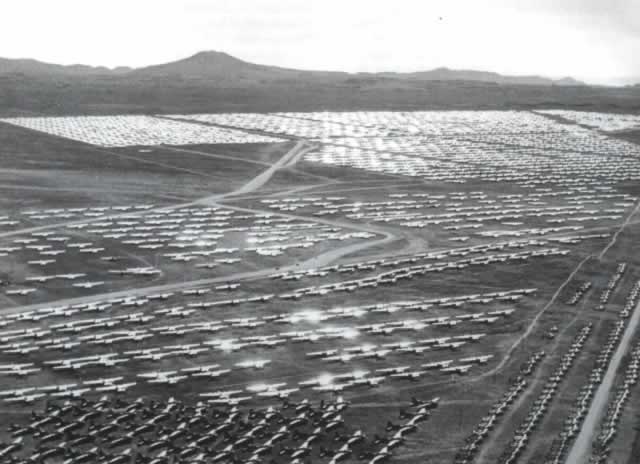 Aircraft awaiting sale, or the furnaces, at Kingman AAF after WWII |
The contractor was the Wunderlich Contracting Company of Jefferson City, Missouri, who received an 18-month contract from the federal government for $2.78 million to reduce 5,400 aircraft to aluminum ingots.
Active duty military personnel typically flew the aircraft into Kingman, and civilian employees would handle parking and classification. To accommodate the large numbers of employees, tent cities were erected on site. In subsequent months, brand new aircraft directly from assembly lines were disposed of at Kingman.
Three furnaces were operated at Kingman for melting the airplane components.
It is estimated that about 5,500 airplanes were flown to Kingman in 1945 and 1946 for sale and disposal. Among the Kingman inventory were B-17, B-24, B-25, B-26, Consolidated B-32, P-38, P-63 and A-20 aircraft.
... about Kingman Army Airfield and Kingman Airport, with photos
Walnut Ridge in Arkansas
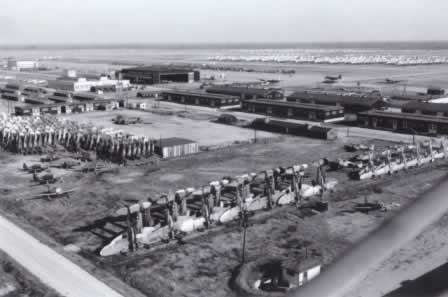 Fighter boneyard at Walnut Ridge, Arkansas, post World War II |
Walnut Army Air Field, located in northeast Arkansas, was activated on August 15, 1942, with the arrival of the initial contingent of key military personnel. Designed for 5,114 military personnel, and 976 civilians, the Air Field had three 5,000-foot runways, a huge apron covering over 63 acres, four large hangars, base engineering building, and fully equipped 203 bed hospital.
After the war was over, Walnut Ridge was an ideal site for surplus aircraft storage because of its large land area and large parking ramp.
As many as 250 airplanes arrived each day. An estimated 10,000 to 11,000 warplanes were flown to Walnut Ridge in 1945 and 1946 for storage , sale, or scrapping. At least 65 of the military’s 118 Consolidated B-32 "Dominator" heavy bombers were flown to Walnut Ridge, many straight from the assembly line in Fort Worth. Also, large quantities of Curtiss P-40 Warhawk fighters were stored there awaiting the smelter; many of these were stored vertically to save space.
 |
Ontario Surplus Depot at Cal-Aero Field
Cal-Aero Academy was a civilian aviation school, established before World War II, and later contracted by the AAF to train pilots. While working with the Army, the school trained Army Air Cadets to fly Stearmans and BT-13s.
The Cal-Aero Academy was closed on October 16, 1944, after training 10,365 fighter and bomber pilots for the war effort.
Cal-Aero Field was located east of Los Angeles, near Chino and Ontario, California.
After the war, the Reconstruction Finance Corporation (RFC) established a sales depot at the inactive Cal-Aero Field, although it was referred to by the RFC as "Ontario". The agricultural area around the airfield was an excellent storage location for surplus military aircraft.
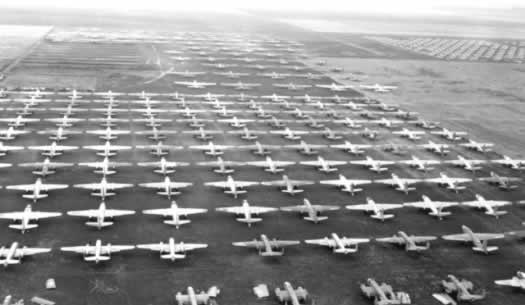 Aerial view of surplus military planes in storage at Cal-Aero Field in California after WWII (Photo used by permission of the photographer, William T. Larkins) |
Nearly 1,900 aircraft would be transferred to Cal-Aero, of which about 500 were sold and the rest dismantled.
Among the aircraft types sent to Cal-Aero were the following:
- Curtiss C-46 Commando
- C-47 Skytrain
- P-40 Warhawk
- P-51 Mustang
- P-38 Lightning
- B-17 Flying Fortress
- B-24 Liberator
- B-25 Mitchell
- B-26 Marauder
- and other aircraft
One smelter was operated by the Sharp & Fellows Contracting company to melt the aircraft parts from Cal-Aero, offsite at Norco, CA.
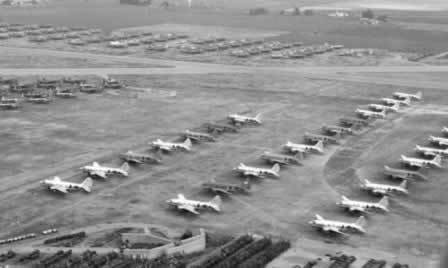 Aerial view of surplus C-46 Commandos in storage at Cal-Aero Field after WWII (Photo used by permission of the photographer, William T. Larkins) |
Many C-46 Commandos were sent to Cal-Aero Field (see photo to the right) for storage, sale and disposal. In later years the C-46 went back to war, serving in both the Korea and Vietnam conflicts for various U.S. Air Force operations, including resupply missions, paratroop drops, and clandestine agent transportation. It also has seen use in many nonsked airlines and cargo operations.
Beginning in the early 1970s, the airport became the center of the warbird restoration movement in Southern California. Cal-Aero Field today is known as Chino Airport.
Chino Airport (CNO) is classified as a general aviation reliever airport, due to its close proximity to Ontario International Airport. It has become a major source of economic and recreational opportunity for the county of San Bernardino, which maintains the airfield.
It is also the home of two excellent aircraft museums, the Planes of Fame Air Museum and the Yanks Air Museum.
Albuquerque Army Air Base and Oxnard Field
 Curtiss C-46A Commando, S/N 42-3649, for sale at Cal-Aero Field, California, post-WWII (Photo used by permission of the photographer, William T. Larkins) |
Albuquerque in the 1930s was served by two private airports, West Mesa Airport and Oxnard Field. In 1935 it was suggested that the city build a new public airport, and ground was broken in 1937. Albuquerque Municipal Airport opened in 1939 several miles to the west of Oxnard Field, with two paved runways.
Construction of Albuquerque Army Air Base began in January of 1941 and was completed in August 1941 on land adjacent to the municipal airport. The base provided advanced flying training and transition training in combat-ready aircraft, primarily the B-17 Flying Fortress and the B-24 Liberator.
The name of the facility was changed to Kirtland Army Air Field in February of 1942.
In March 1945, Kirtland Field was converted into a B-29 Superfortress base. From Kirtland Field, Manhattan Project scientists were flown back and forth to Wendover Army Air Base and Los Alamos.
With the end of World War II, Oxnard Field began receiving surplus military bombers and fighters. The field received over 1,500 old aircraft onto its unpaved runways, such as obsolete B-24 Liberator and B-17 Flying Fortress bombers, as well as P-38 and P-51 fighters and other aircraft. The aircraft were to be sold or demolished at the site, and most were in fact recycled by the Compressed Steel Corporation.
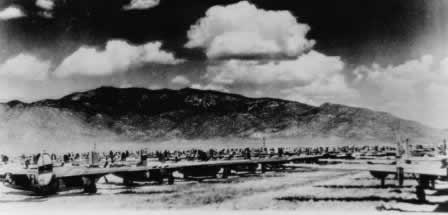 Albuquerque aircraft storage, 1946 |
Oxnard later became part of Kirtland Air Force Base, the Air Force's main facility for integrating new weapons designs produced by Sandia Laboratory with operational USAF aircraft and equipment.
Clinton Naval Air Station
Clinton Naval Air Station was located 15 miles southwest of Clinton, and 120 miles west of Oklahoma CIty. It was established in 1942 as a training station for naval aviators.
After World War II was over, the facility was closed in June of 1946. It served as a boneyard for over 8,000 US Navy aircraft. By April of 1946, over 8,800 military planes were stored at Clinton, mostly F6F Hellcats, FM Wildcats and TBM Avengers.. While some were sold to individuals or companies, most were dismantled, melted in one of the two furnaces on site, and sold as scrap to the Sherman Machine and Iron Works of Oklahoma City.
In 1949 the base was transferred to the City of Clinton, only to be reclaimed by the Defense Department in 1954 for the establishment of Clinton-Sherman Air Force Base. The base was revamped and new runways were built to accommodate the Boeing B-52 Stratofortress of the Strategic Air Command. The base was closed in 1969.
Other post-WWII Naval storage and reclamation facilities were located at NAS Litchfield Park near Phoenix, and NAS Norfolk in Virginia. Litchfield Park remained on active status until 1965 when its operations were transferred to Davis-Monthan AFB.
Altus Army Air Field
Altus Army Air Field in Oklahoma was activated in early 1943, and served as an Advanced Flying School until April of 1945. The primary training aircraft were the Boeing-Stearman Kaydet T-17 and the North American T-9.
After the students perfected their skills with these planes, they transferred to units that prepared them to fly the type of aircraft they would use in combat over Europe and in the Pacific theater during World War II. With an average of over 300 days of weather conducive to flying each year, a generally flat landscape and few obstructions, the base was well situated for young airmen to hone their flying skills.
Between 1945 and 1953 it would serve as a boneyard for thousands of surplus World War II era military aircraft.
About 2,500 aircraft were stored, sold or scrapped there after WWII, including B-17, B-24, B-25, P-38, P-40, P-51 and P-47 aircraft. Most of the B-17s sent to Altus for storage were new "G" models right off the assembly line, which created a strong market to private sector buyers.
The B-17F "Memphis Belle" was honored in 1943 as the first B-17 heavy bomber to complete the then-mandatory 25 missions. The plane and its crew returned to the United States during the summer of 1943 for a highly publicized public relations tour. In 1945 "Memphis Belle" was discovered at Altus awaiting disposal, and the City of Memphis was able to obtain the historic plane. The aircraft was subsequently saved and restored.
 B-17 "Memphis Belle" would be stored at Altus AAF after public relations tour |
By May of 1948, the inventory of aircraft was decimated, and the facility was turned over to the City of Altus for use as a municipal airport. In 1953 the airport was reopened as Altus Air Force Base, which remains an active facility today.
Searcy Field in Stillwater, Oklahoma
Stillwater Municipal Airport was built in 1939, and improved in 1943 with the additional of three 5,000 foot concrete runways. The U.S. Navy operated the facility as an outlying field for NAS Clinton, Oklahoma. After the war, Searcy Field was transferred to the Reconstruction Finance Corporation and used to store nearly 500 aircraft. The inventory included B-24 Liberators, B-17 Flying Fortresses, P-40 Warhawks, Navy PB4Y-1 and other aircraft types.
In February of 1946 the inventory of 475 surplus aircraft at Searcy was purchased by Paul Mantz, a recognized aviation expert, at a cost of about $117 each. He kept 11 of the aircraft for his own use, and the remaining 464 were cut up and shipped to St. Louis, Missouri, where they were melted.
Victory Field in Vernon, Texas
About 1,300 aircraft were stored, sold or scrapped at this airport west of Wichita Falls, Texas.
Longer-Term Military Aircraft Reserve Storage Facilities
By 1947 the WAA had disposed of about 65,000 aircraft. However, some aircraft would be stored in reserve and retained for future return to active duty.
Planes were stored at several locations across the country, including
- Victorville in California
- Pyote in Texas
- Warner Robins in Georgia
- Litchfield Park / Phoenix Goodyear Airport (GYR)
- Davis-Monthan in Arizona
... about long-term storage facilities for military planes after WWII
Photographs of Post-World War II Aircraft Boneyards
Aerial view of Davis-Monthan Air Force Base, May 1946, showing more than 600 B-29 Superfortress and 200 C-47 aircraft |
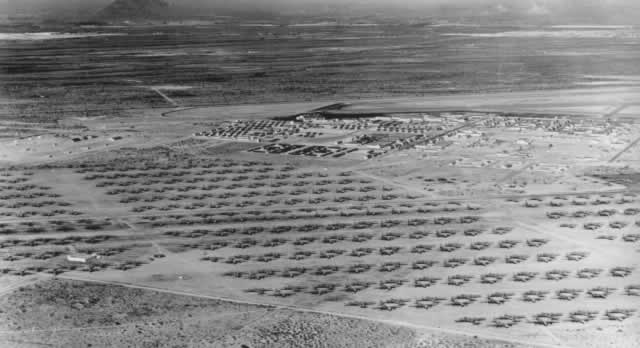 |
Aerial view of surplus military aircraft in storage at the Kingman aircraft boneyard in 1946 |
 |
Aerial view of Walnut Ridge, Arkansas, in November, 1945 (Walnut Ridge Army Flying School Museum) |
 |
B-32 Dominator bombers stored at Walnut Ridge, Arkansas, after World War II (Walnut Ridge Army Flying School Museum) |
 |
B-29 Superfortress bombers in storage at Pyote Air Force Base, Texas, circa 1946 |
 |
Boeing B-29 Superfortress "Enola Gay" ... in storage at Pyote AFB in Texas after World War II |
 |
Boeing B-29 "Bockscar" in storage at Davis-Monthan AFB Now restored and on display at the Museum of the United States Air Force in Dayton, Ohio |
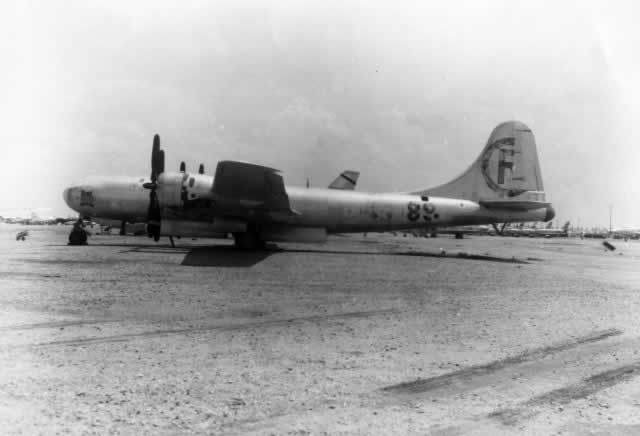 |
B-29 Superfortress cocooning at Warner Robins Air Material Area in Georgia, July, 1946 |
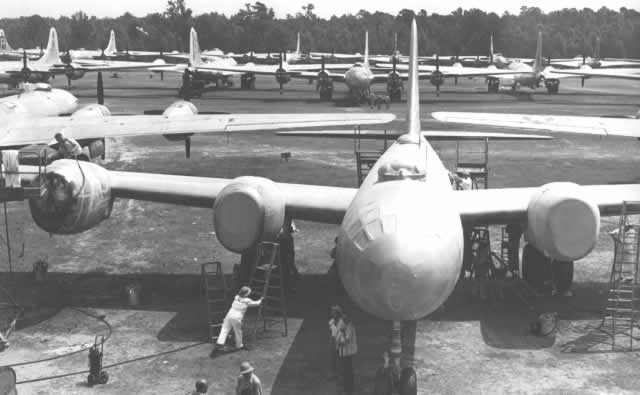 |
Aerial view of surplus military aircraft in storage at Cal-Aero Field, California after WWII (Photo used by permission of the photographer, William T. Larkins) |
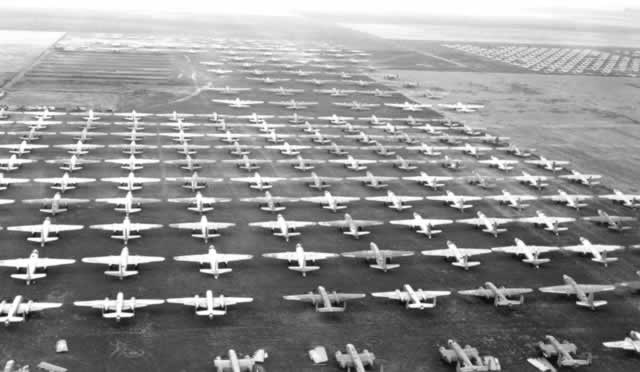 |
Bomber Scrapping and Smelting Process at the Kingman Army Air Field boneyard in Arizona
Rows of B-24 Liberators await the scrap heap at Kingman AAF in Arizona "Old Black Magic" 0333 in the foreground |
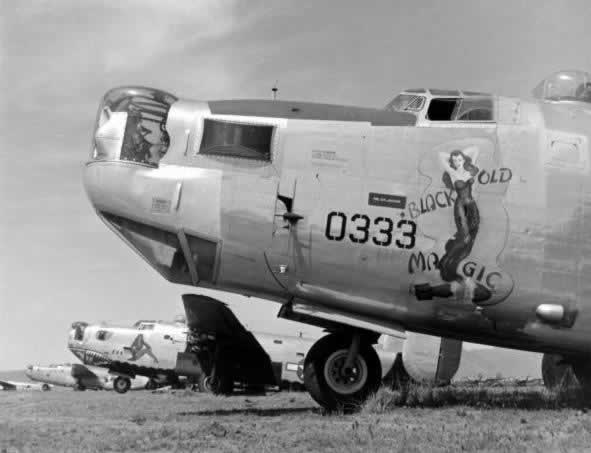 |
B-24 Liberator "Mabel's Labels" ... "Gimme a Great Big Smile!" engines removed and awaiting the guillotine and smelter |
 |
Rows of aircraft engines removed from surplus bombers at the Kingman, Arizona boneyard |
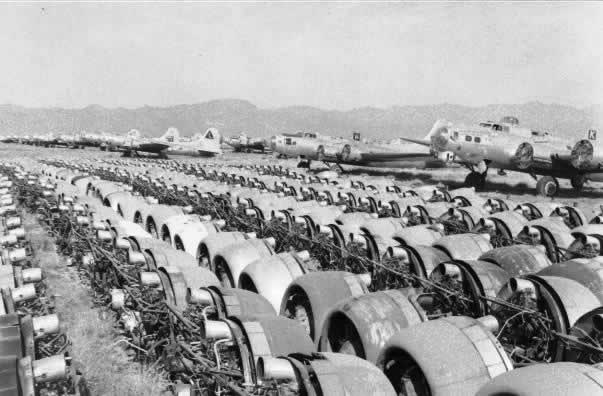 |
B-24 Liberator "Missouri Miss" meets the guillotine at Kingman Army Air Field |
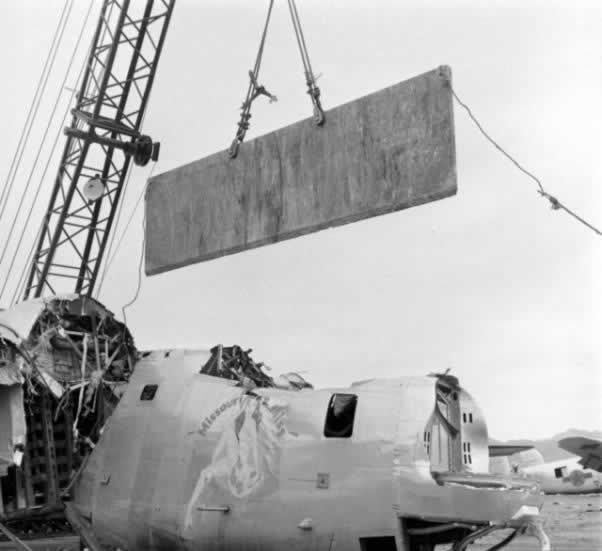 |
Once cut in pieces, aircraft remnants are moved to the smelter (in the distance). Remains of B-24 serial number 250536 in the foreground. |
 |
|
Map of locations of active & post-WWII airplane boneyards and plane storage facilities in the United States






